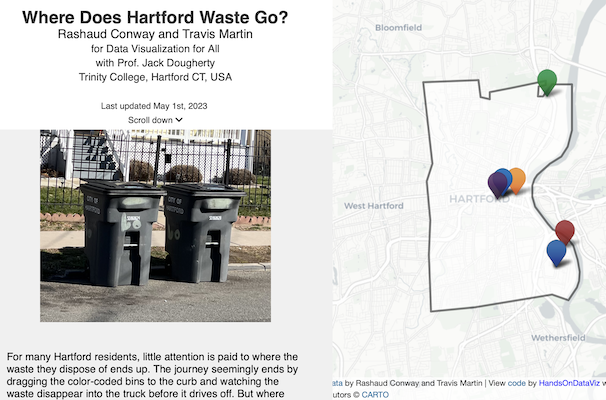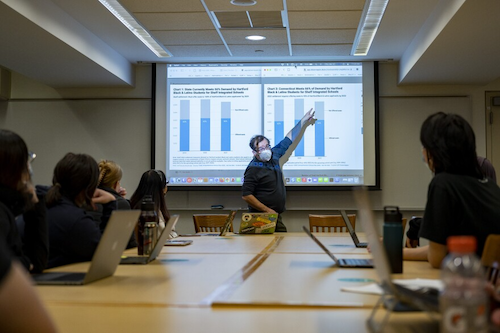Partners and Projects
Fall 2024
Affordable Homeownership
Our community partner, the Center for Leadership and Justice, asked us to answer questions about their Urban Suburban Affordables, Inc. (USA) community land trust program, launched in the mid-1990s as a strategy to maintain affordable homeownership. CLJ provided a list of 211 USA homes across the Hartford region, purchased by low-to-middle income buyers, while the community trust owns the land and sets the maximum resale price to maintain affordability for the next generation. Trinity student authors focused on specific questions, then collected, analyzed, and visualized their findings in data stories below. We report coded or aggregated findings because we agreed not to publish individual addresses to maintain homeowner privacy.
Intro video for CLJ USA community land trust affordable homeownership project, Fall 2024
Question 1: How many USA homes are located across Hartford-area towns, and how does the program compare with other community land trusts?
Exploring Homeownership Through the Urban Suburban Affordables Program, by Nellie Conklin (Teaching Assistant)
Question 2: Where are USA homes located and in what types of neighborhoods by demographic characteristics?
Targeting Affordable Housing: Analyzing Income and Eviction Data to Guide the USA Program’s Impact in Greater Hartford, by Colin McCarthy & Ethan Opdenaker
Mapping Change: Advancing Housing Equity and Stability in Connecticut’s Communities, by Ralston Raphael & Ethan Roush
Question 3: How have USA home sales prices and ownership trends changed over time, in Hartford and suburban towns?
A Look Back: How Homeownership Trends and Prices of USA Homes Have Evolved in Hartford, by Jana Safy & Hameed Almukhtar
A Dive Into Urban Suburban Affordables Homeownership Trends and Sales in West Hartford and East Hartford, by Walter Schwartz and Luca Steinert
Navigating Greater Hartford: Unraveling the Constant Shift in Housing Market Trends among USA Homes in Windsor and Bloomfield, by Sally Brunelle and Hayes Talbot
Question 4: How much homeownership wealth has the USA program created in Hartford neighborhoods?
How USA Land-Trust Homes are Building Wealth While Keeping Homes Affordable in the North End of Hartford, by Julia Boucher & Gabbie Marcuccio
Homeownership - The Leading Wealth Creator for the American Working Class: A Focus on USA Homes in South Hartford, by George Zack and Priya Mester
Question 5: How do USA homes measure up to block or neighborhood comparison groups in Hartford neighborhoods where homes are clustered?
USA Homes Vs. Non-USA Homes in Northwest Hartford, by Demetra and Lillie
How Does Your USA Land Trust Home Compare to Similar Homes in Southwest Hartford?, by Ainsley Steele & Elizabeth Murphy
Fall 2023
Child Care and College Access
For our Child Care projects, Izzi Greenberg, Executive Director of Middlesex Coalition for Children and Merrill Gay, Executive Director of CT Early Childhood Alliance asked us to help visualize answers to this broad question: How and why does child care availability, affordability, and quality vary across Connecticut, and what can we learn from improvement strategies outside the state?
Intro video for Child Care project, Fall 2023 with partners Izzi Greenberg, Executive Director of Middlesex Coalition for Children and Merrill Gay, Executive Director of CT Early Childhood Alliance.
Update: Maps from the first two data stories below were featured in a news report: Hugh McQuaid, “Child Care Panel Recommends Boosting Funding and Subsidized Day Care Slots,” CT News Junkie, December 13, 2023, https://ctnewsjunkie.com/2023/12/13/child-care-panel-recommends-boosting-funding-and-subsidized-day-care-slots.
A Crisis of Availability: Childcare in Connecticut for Children 0-3 years old, by Kelly Thomas & Lily Ryan
Is Child Care Really Affordable in Connecticut Towns? by Josh Ruthfield and Nellie Conklin
Quebec Child Care Subsidy Program: What can Connecticut do Better to Help Parents get Back to Work? by Diana M. Lee and Angelina R. Varghese
For our College Access projects, Melissa Paul, Director of College Partnerships + Reaching Forward at Hartford Promise, asked us to help visualize answers to this broad question about “successful matches” for their scholarship program: What measurable factors might explain why comparable groups of Hartford Promise scholars (from high school classes of 2016 and 2017) tend to experience success in college, relative to other students at these institutions?
Intro video for College Access project, Fall 2023 with partner Melissa Paul, Director of College Partnerships + Reaching Forward at Hartford Promise
Measuring the Graduation Rates of Hartford Promise Scholars at 4-Year Private Institutions by Savannah Brooks and Emma Kozak
Where are Public College Hartford Promise Success Stories? by Brendan Feldgoise and Oliver Dahlen
Hartford Promise Scholars pursuing 2 year Colleges by Jackson Camporin and Jack Brown
Hartford Promise Students Find Different Success Rates at CT Auto-Admit Colleges, by Will Scannell
Hartford Promise Scholars Shine as UConn Graduates by Dillon McDermott and Colin Leonard
Exploring Academic Horizons: Hartford Promise Scholars In-State vs. Out-of-State College Success Stories, by Pom Somchanmavon and Tony Ortega
College Interruption Rates and Their Effect on Hartford Promise Students by Conor Bradley & Garrett Kirk
Food Scrap Pilot Program
Former DataViz student Shayla Whitaker earned a Community Learning Research Fellowship to collaborate with two community partners on this Fall 2023 project:
Visualizing Connecticut Food Scrap Pilot Programs: Representation, Participation, and Benefits, by Shayla Whitaker, Community Learning Research Fellow, Center for Hartford Engagement and Research (CHER) at Trinity College, with community partners: CT Dept. of Energy and Environmental Protection (CT DEEP) and the Center for Leadership and Justice (CLJ).
Abstract: We are in a trash crisis. A large portion of waste that goes to incinerators and landfills is food scraps, one of the heaviest types of waste and one of the largest sources of methane. In 2022-23, the Connecticut Department of Energy and Environmental Protection (CT DEEP) awarded Sustainable Materials Management grants to fund food scraps pilot programs by local governments to divert food scraps from the waste stream. Studying questions about representation, participation, and benefits of these programs gives us a better understanding of their strengths and weaknesses and potential implementation at a larger scale. Among 15 grant awards across the state, data collected from West Hartford and Stonington showed these two pilot programs represented wealthier and whiter areas, an average 46 percent participation rate (for West Hartford), and food scrap diversion rates ranging from 5 to 17 percent. Policy recommendations: DEEP should require towns to collect more uniform data, and make it accessible for the public to learn from these pilot programs.
Spring 2023
Crash (with City of Hartford) and Trash (with Center for Leadership and Justice)
For our Crash projects, Grace Yi (Senior Planner, Bike & Ped) and Owen Deutsch (Principal Planner), from the Planning Division, City of Hartford, asked us to help visualize answers to this question: When and where are the highest frequency of motor vehicle crash injuries and fatalities in Hartford, and what can we learn about traffic-calming measures?
Intro video for Crash project, Spring 2023 with partners Grace Yi and Owen Deutsch Planning Division, City of Hartford

Analyzing The Impact of Hartford’s Traffic Calming Installations by Keelyn McNamara (Teaching Assistant)
Has the Installation of Speed Humps on Flatbush Avenue Affected Crash Data? by Alison MacDougall & Caroline Lally
When Do Hartford Crashes Happen? by Theodora Tatsi
What types of crashes have been occurring in Hartford, and who is being affected? by Evan and Joe
Which Hartford Corridors Have the Most Crashes? by Isaac Frank and Chris Horkan
Crashes at Major Hartford Intersections in 2018-2022 by Jess Cruz and Mia Rodriguez
For our Trash projects, Sarah McCoy from the Center for Leadership and Justice in Hartford has asked us to help visualize answers to this environmental racism question: Where does our trash go, whose neighborhoods are affected, and how much can we reduce solid waste?
Intro video for Trash project, Spring 2023 with partner Sarah McCoy, Center for Leadership and Justice

Where Does Hartford Waste Go? by Rashaud Conway and Travis Martin
Environmental Racism in Hartford County by Rachel Kim and Liv Crowley
Note: Two students below were assigned to explore patterns in 2021 CT DEEP Municipal Solid Waste town-level data estimates, which includes many questionable outliers marked in yellow in the instructor’s spreadsheet.
Where Most of Our Recycling Comes from Near the Hartford Area by James Yarussi
The Relationship Between Waste and Recycling in Connecticut by Colin Hedge
Parkville Neighborhood
Former DataViz student and TA Victoria Asfalg ‘23 collaborated with Hartford community partner and Clark University graduate student Zoe Chatfield on this Spring 2023 data story, Parkville’s Property: Who Influences Development? A Case Study on a Hartford, CT Neighborhood, which features several interactive maps and charts, built on City of Hartford property assessor data.
Abstract: Walking through Parkville today, you might be drawn to Parkville Market, Connecticut’s first food hall, with a variety of scents and flavors from cuisines around the world. Or you might notice Gather55, a pay-what-you-can restaurant serving up meals prepared by professional chefs. Or maybe your attention will be caught by the Curioporium, a museum-esque store full of oddities and legends. But what you might not know about these businesses, unless you have lived in Hartford for a while, is that all of them are less than a decade old. In the past 20 years or so, Hartford’s Parkville neighborhood has seen significant change. I sat down with Clark University Master’s student Zoe Chatfield to further discuss the change that is happening in Parkville. Her thesis is on how Hartford’s housing has shaped Parkville. We wondered, who is behind this change? What are their intentions? To answer these questions in a meaningful way, I decided to create a data story with original visualizations that would supplement Zoe’s thesis. The broad goal of this data story is to answer these questions: How has the housing landscape of Parkville changed? How has commercial development in Parkville changed? Who influences development in Parkville? and, more importantly, What are their visions and goals for this neighborhood? Are these visions and goals being met?
Fall 2022
Center for Leadership and Justice (CLJ) and Education Funding Inequities
Our partners at CLJ asked us to help them analyze and visualize student residency and school district funding for their Greater Hartford Interfaith Action Alliance (GHIAA) Education Research team. We defined the metro Hartford area as a contiguous 33-town region, which includes 38 public school districts when counting magnets and charters. Also, we appreciate expert guidance on Connecticut education funding provided by the School + State Finance Project.
Intro video for Fall 2022 students with Center for Leadership and Justice partners: Marika Stewart, Jocelyn Gardner Spencer, Sarah McCoy
Exploring the Relationship Between School Type and Per-Student Spending, by Keelyn McNamara
The Big Disconnect: How Instructional Spending Does Not Match Student Enrollment Over Time, by Emiko Saso
How funding is distributed in Hartford-region Schools for Students with Disabilities by Anna Tran
What is the Relation Between Racial & Ethnic Enrollment and Per-Student District Spending? by Liam O’Connor and Ben Bejoian
English Language Learners, School Type and Per-Pupil Spending by Mia Zajec
Examining School Expenditures in the Greater Hartford Districts by Cam
Where are High-Needs Students in the Hartford Region? by Natalie J. S-G
Increasing Rates of Students Educated Outside of Their Home Districts by Jack Reiling
How Has Enrollment Changed in Towns and School Types from 2016-2022? by Faris Matraji
The Changes in Student Population and Per Pupil Expenditure in Hartford Region by Robert E. Groebel IV and Shayla Whitaker
Locating Our Schools by Julianna and Viv
Spring 2022
Sheff v O’Neill 2022 School Integration Settlement
Since several students who completed the DataViz For All course later enrolled in my Educ 308: Cities Suburbs and Schools course, we worked together on another community-learning partnership. Our mission was to communicate the goals of the January 2022 Sheff v. O’Neill school integration settlement to broad audiences. Students designed and revised five data visualizations based on feedback collected from individual members of the Sheff Movement, and published final versions in this May 2022 story by Jacqueline Rabe Thomas for CT Public Investigative News.

January 2022
CT Coalition Against Domestic Violence (CCADV)
Our partners at CCADV asked us to help them analyze and visualize the first two years of de-identified data from CTSafeConnect.com, a new statewide hotline for people requesting help regarding intimate partner violence. To protect confidentiality, CCADV created a masked dataset with 50,000 rows of individual contacts between clients and staff, which we masked further by aggregating into 15 regions that resemble local service areas for use in students’ data stories.
Intro video for J-term 2022 students with CT Coalition Against Domestic Violence partners: Maria Guzman and Joanne Vitarelli
Additional data stories:
Racial Demographics of Callers to CT Safe Connect, by Daisy Li
CT Safe Connect Repeat Callers by Demographics and Services, by Alberlis Hernandez
Where are CCADV’s frequent callers and what do they want?, by Archana Adhikari and Azka Hassan
CCADV Support Services Across Connecticut, by Burke Hinton and Jeff Pendergast
CT Safe Connect Minutes Spent Per Region, by Chris Perry and Lachlan Berry
Is Regional Income Linked to CT Safe Connect Calls?, by Ryan Wiley
White CTSafeConnect Contacts Based on Region and Population Density, by Timothy Hall and Peter Keigher
CT SafeConnect’s Services Provided and Last Instances, by Michael Kulik and Jack Impronto
Fall 2021
Center for Leadership and Justice (CLJ) and #NoMoreSlumlords
Our partners at CLJ asked us to help them analyze and visualize data related to their Greater Hartford Interfaith Action Alliance (GHIAA) organizing and their #NoMoreSlumlords campaign for stronger housing code accountability by the Hartford city government.
Intro video for Fall 2021 students with Center for Leadership and Justice partners: Cori Mackey, Tieasha Gayle, AJ Johnson.
DataVizForAll students at Trinity cleaned and geocoded CLJ data for this map. View full-size version.
Hartford Housing Legislation and When Neighborhoods Will Be Impacted by Elizabeth “Bonnie” LaBonte and Lachlan Clark
Who Are the Largest Hartford-Based Apartment Owners?, by Steven Ramsden
Hartford Housing Cases, by Ifham Majeed and Greg Linton
The Relationship Between GHIAA Membership, Presence, and Town Demographics, by Theodore Wong
Reflection video, Dec 2021 with Center for Leadership and Justice partners: Cori Nicewander, Tieasha Gayle, AJ Johnson.
Hartford Area Habitat for Humanity and Housing
Our partners at Hartford Area Habitat for Humanity asked us to help them compile and visualize data on the 250 homes they constructed or fully rehabilitated in the region since 1990.
Intro video for Fall 2021 students with Hartford Area Habitat for Humanity partners: Suzanne Feola, Makenzie Bahr, Tracy Thomas, Karraine Moody.
DataVizForAll students at Trinity compiled, cleaned, and geocoded Habitat data for this map. View full-size version.
Hartford-Area Habitat for Humanity has Expanded Construction Outside Hartford Over Time by Myrian Ayala and Emma Wellins
Where has Habitat built homes in North Central Connecticut over the last three decades? by A. Nassar
Neighborhoods Where Hartford Habitat Has Built Homes And Why It Matters: Examining Opportunity and Income in Census Tracts by Victoria Asfalg and Riley Nichols
Where has Habitat been building homes and why does this matter? by Theodore Komjathy
Habitat Homes Generate over $850,000 in Property Taxes for Local Governments by Nolan McKenna
Reflection video, Dec 2021 with Hartford Area Habitat for Humanity executive director: Karraine Moody.
